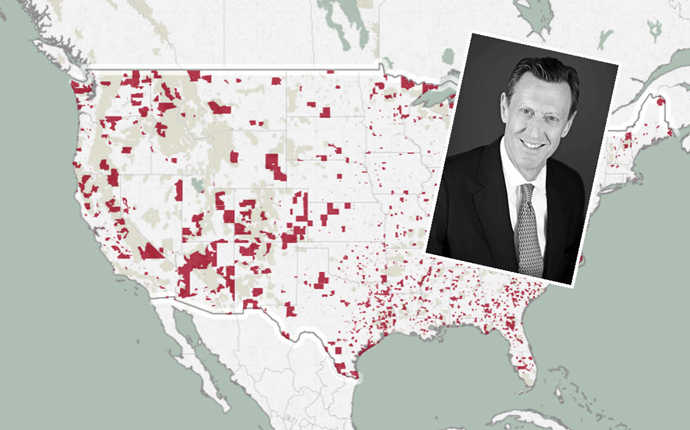Everyone in real estate may seemingly be talking about Opportunity Zones, but few industry players have started closing on such projects.
That’s what makes Bridge Investment Group’s recent announcement unique. The Salt Lake City-based real estate firm said earlier this month that it has already deployed $509 million into a dozen Opportunity Zone projects in eight metropolitan areas across the country. The list of projects includes multifamily, office and industrial properties.
The Opportunity Zone program itself gives developers and investors the ability to defer and potentially forgo paying capital gains taxes if they buy and hold a property in specially designated locales, many of which are in distressed areas, for at least five years.
Large investors such as Brookfield Asset Management, EJF Capital, RXR Realty and Starwood Capital Group have raised hundreds of millions of dollars to pour into Opportunity Zones, but Bridge is one of the first to actually start buying property and putting shovels in the ground.

Bridge’s chief strategy officer David Coelho
In a recent interview with the The Real Deal, Bridge’s chief strategy officer David Coelho provided a sneak peek into how the firm is investing in Opportunity Zones and dealing with a bevy of complex regulations surrounding the program.
Avoiding the “tulip craze”
The increased interest in Opportunity Zone sites has created a major problem. In an effort to reap a windfall from thirsty investors, many property owners have drastically raised the prices on properties in such zones. One South Florida developer has compared the phenomenon to the tulip mania of 1637, when the price of tulips in the Netherlands rose exponentially before collapsing.
Bridge, however, has managed to largely avoid the land speculation game. The firm, which has $16 billion in assets under management, focuses on value add opportunities by working with local partners who already have properties under their control in Opportunity Zones. Bridge then invests in those properties, often by doing deals where the underlying real estate was purchased before prices spiked in the aftermath of the Opportunity Zone legislation, which was shoehorned into the Trump administration’s 2017 federal tax overhaul.
“We are not out there actively bidding on Opportunity Zone development sites, we are primarily working with partners that have land under control,” Coelho said. “When we lose the ability to execute in that manner is probably when will stop investing in Opp Zones.”
If they’re not already too expensive, another issue with Opportunity Zones is that many are not yet development ready. This is especially true in New York City, where land prices are already high and if an investor wants to qualify for the program’s tax benefits one must either double the value of the property or have a plan for new development.
“New York is a particularly tough market,” Coelho said. “We get solicited all the time to buy land in the boroughs and that’s just something we are not interested in doing.”
Complications arise
Some developers have stayed away from the Opportunity Zone program in large part due to the thicket of regulations they must navigate to in order to qualify for tax breaks. Bridge’s Coelho said such rules make it difficult to structure deals and deploy capital into Opportunity Zone projects.
With a few exceptions, the rules require investors to deploy capital 31 months after raising it which can often be tough for real estate firms. Developers are used to coping with complications that arise and unforeseen costs that can emerge during the course of a particular project. Sometimes developers must raise more capital or change their plans.
Coelho said he has found that adding new capital is complicated if you want to bring in new Opportunity Zone funds to a project, as investors will then have to wait longer in order to reap the full tax benefits. As a result, Bridge made sure its Opportunity Zone projects were fully entitled and shovel ready before making an investment.
“The inability to fully inject equity capital at future stages means that you have to have your capital plans really planned at the front end,” Coelho said. “These deals have to be more or less packaged and ready to go.”
Bridge has invested in various Opportunity Zone sites around the country, including in Atlanta, Los Angeles, the New York borough of Queens, Sacramento, Salt Lake, the Bay Area in San Francisco, the suburbs of Washington, D.C., and Portland, Oregon.
Coelho said his firm’s Opportunity Zone deals were in places where Bridge would have already invested regardless of any special designation, using the refrain that Opportunity Zones don’t necessarily turn a bad real estate deal into a good one.
“These aren’t pioneering deals by any stretch, they are in established markets,” Coelho said.
Critics of the Opportunity Zone program worry that only wealthy developers are benefiting from its tax breaks and that the money will go toward areas that have already been developed or are gentrifying, such as former hospital site in Chicago home to a $2 billion mixed-use redevelopment project and the $4 billion SoleMia mixed-use project in North Miami.
But Coelho claims that such tax breaks give Bridge and other firms the incentive to do deals and build projects faster. While these areas may already have the attention of developers, supporters believe the advent of Opportunity Zones has helped jumpstart their development efforts.
“The Opportunity Zones initiative gives us a little bit of push to get these deals across the finish line,” Coelho said.
